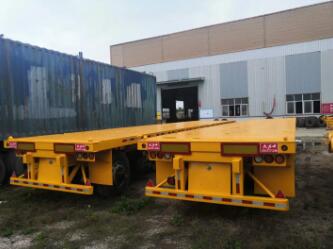How to Choose the Right 3-Axle Flatbed Semi Trailer for Your Business
2024-09-07
Investing in a 3-axle flatbed semi trailer is a smart move for businesses involved in freight transport, construction, or logistics. However, choosing the right trailer can be a challenge, given the various specifications, load capacities, and features available. In this blog, we’ll break down the factors you should consider when selecting the ideal 3-axle flatbed trailer for your business.
1. Understand Your Load Requirements
The first step in choosing the right 3-axle flatbed trailer is understanding the types of loads you plan to transport. Flatbed trailers are designed to accommodate a wide variety of loads, from heavy machinery to industrial supplies. Here are some key considerations:
- Load Type: Determine whether your business frequently transports oversized or oddly shaped goods, as a flatbed is ideal for this purpose. If your cargo requires weather protection, an enclosed trailer may be more suitable.
- Weight Capacity: One of the primary benefits of a 3-axle trailer is its increased weight capacity. Ensure that the trailer you choose can comfortably handle your heaviest loads without exceeding legal weight limits for road transport.
2. Evaluate the Material and Build Quality
The material used in constructing the trailer can significantly impact its durability and longevity. 3-axle flatbed trailers are typically made from either steel or aluminum. Here’s a quick comparison:
- Steel Trailers: Steel is known for its strength and ability to withstand heavy loads. It is more resistant to damage and wear and tear but is also heavier, which can reduce fuel efficiency.
- Aluminum Trailers: Aluminum is lighter than steel, which improves fuel efficiency and payload capacity. However, aluminum may not be as strong as steel when carrying extremely heavy loads over long distances.
Consider the environment in which the trailer will be used and how often it will be exposed to corrosive elements like saltwater or chemicals. Steel trailers with galvanized coatings or painted finishes are better suited for corrosive environments.
3. Check the Dimensions and Deck Features
Flatbed trailers come in different lengths, widths, and deck configurations, depending on the type of loads you need to carry. Common deck lengths for a 3-axle flatbed trailer range from 40 to 53 feet, and the width is usually 8.5 feet.
- Length: Choose a length that suits the type of cargo you typically haul. If you frequently transport long items like pipes, beams, or lumber, a longer trailer may be necessary.
- Deck Height: Some flatbed trailers feature lowboy designs, where the deck sits closer to the ground, allowing for the transport of taller loads without exceeding height restrictions.
- Lashing Points: Secure lashing points and side rails are essential for safely securing the cargo during transport. Look for trailers with durable, strategically placed tie-down points that accommodate various load types.
4. Consider Maneuverability and Fuel Efficiency
A 3-axle flatbed trailer provides excellent stability for heavy loads, but it’s essential to consider how the extra axle will affect maneuverability and fuel consumption:
- Maneuverability: If your business involves navigating tight spaces or urban environments, consider whether a 3-axle flatbed will offer the necessary flexibility. A longer trailer may be more challenging to maneuver in congested areas.
- Fuel Efficiency: A third axle adds weight, which can increase fuel consumption. If fuel efficiency is a priority for your business, look for lightweight trailers made from aluminum or other weight-saving materials.
5. Look for Safety Features
Safety is paramount when transporting heavy or oversized loads. Some essential safety features to look for in a 3-axle flatbed trailer include:
- Anti-lock Braking System (ABS): ABS helps prevent the wheels from locking up during braking, reducing the risk of skidding or loss of control, especially when carrying heavy loads.
- Reflective Tape and Lights: Ensure the trailer has adequate lighting and reflective tape to improve visibility on the road, especially when traveling at night or in poor weather conditions.
- Reinforced Ramps and Landing Gear: Reinforced ramps and landing gear make loading and unloading safer and more efficient.
Conclusion
Choosing the right 3-axle flatbed semi trailer for your business involves carefully considering your load requirements, material preferences, deck features, and safety needs. By evaluating these factors, you can select a trailer that not only meets your current transport demands but also provides reliability and cost-effectiveness for the long haul. Whether you’re in construction, logistics, or agriculture, the right trailer will help improve your business’s productivity and ensure that your goods arrive safely at their destination.



